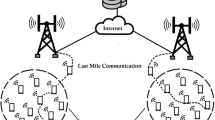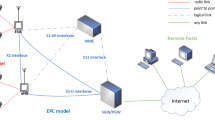Abstract
Widespread deployment of wireless local area networks and a gradual increase in streaming applications have brought about a demand for improved quality of service (QoS) in wireless networks. However, increasing user datagram protocol based high priority multimedia traffic and the class differentiation introduced in QoS protocols, has resulted into transmission control protocol (TCP) starvation and increased spurious timeouts. While today’s Internet traffic is still dominated by TCP based applications, the negative effects of IEEE 802.11e enhanced distributed coordination function (EDCF) scheme on TCP performance in the presence of high priority traffic have not been extensively explored. In this paper, the performance of TCP in 802.11e WLAN competing with high priority traffic is examined. The prioritised adaptive enhanced scheme (PAD_EDCF) is proposed. The proposed scheme gives priority to TCP control packets in order to improve the low traffic transmission flow and acquires additional capability of adjusting the MAC parameters based on the traffic load condition. Simulation results demonstrate that the proposed scheme significantly improves TCP performances in terms of traffic efficiency, throughput and reduces delay.
Similar content being viewed by others
References
IEEE802.11 W. (2002). Draft supplement to standard for telecommunications and information exchange between systems—LAN/MAN specific requirements—Part 11: Wireless medium access control (MAC) and physical layer (PHYI specifications: Medium access control (MAC) enhancements for quality of service (QoS)).
Tuysuz, M. F. (2011). A local estimation of node quantity and channel density for VoIP applications over IEEE 802.11e WLANs. In Information technology and multimedi (ICIM), Turkey.
Peng, F., Ripeanu, M., & Qian, D. (2008). Performance analysis of transmissions opportunity limit in 802.11e WLANs. In Communications and networking simulation symposium, Ottawa.
Vassis D., Kormentzas G. (2005) Delay performance analysis and evaluation of IEEE 802.EDCA in finite load conditions. Wireless Personal Communications 34: 29–43
Artail H., Safa H., Naoum-Sawaya J., Ghaddar B., Khawam S. (2006) A simple recursive scheme for adjusting the contention window size in IEEE 802.wireless ad hoc networks. Computer Communication 29: 3789–3803
Frikha, M., Said, F. B., Maalej, L., & Tabbana, F. (2006). Enhancing IEEE 802.11e standard in congested environments. In International conference on internet and web applications and services/advanced international conference on telecommunications (pp. 78–80), Guadeloupe.
Bandinelli, M., Chifi, F., Fantacci, R., Tarchi, D., Vannuccini, G. (2005). A link adaptation strategy for QoS support in IEEE 802.11e-based WLANs. In IEEE wireless communications and networking (pp. 120–125), New orleans.
Calafate, C. T., Manzoni, P., & Malumbres, M. R. (2004). Assessing the effectiveness of IEEE 802.11e in multi-hop mobile network environments. In Modeling, analysis, and simulation of computer and telecommunications systems (pp. 205–212).
Torres A., Calafate C.T., Cano J.-C., Manzoni P. (2012) Assessing the IEEE 802.11e QoS effectiveness in multi-hop indoor scenarios. Ad Hoc Networks 10: 186–198
Putra, E. H., Supriyanto, E., Bin Din J., & Satria, H. (2011). Cross layer design of wireless LAN based on H.264/SVC and IEEE 802.11e. In Electrical Engineering and Informatics (ICEEI) (pp. 1–6). Indonesia.
Habib, G., & Cran, N. (2011). Dynamic adaptation of IEEE 802.11e priorities for improving temporal performance and safety of a wireless networked discrete control system. In Dependable Control of Discrete Systems (DCDS), France.
Mbarushimana, C., Shahrabi, A., & Buggy, T. (2008). A cross-layer support for TCP enhancement in QoS-aware mobile ad hoc networks. In MSWiM, Vancouver.
Floyd S., Fall K. (1999) Promoting the use of end-to-end congestion control in the internet. IEEE/ACM Transactions on Networking 7: 458–472
Kim, M., Ye, H.-J., & Cho, S.-J. (2006). QoS-aware wireless MAC protocol using network load adaptation. In Sixth IEEE international conference on computer and information technology (CIT’06) (p. 95), Korea.
Bianchi G. (2000) Performance analysis of the IEEE802.distributed coordination function. IEEE Journal on Selected Areas in Communications 8: 525–547
Latif, S. B. A. (2010). Protocol design for real time multimedia communication over high-speed wireless networks. In School of Engineering, College of Sciences: Massey University.
Deng D.-J., Cheng R.-S., Chang H.-J., Lin H.-T., Chang R.-S. (2009) A cross-layer congestion and contention window control scheme for TCP performance improvement in wireless LANs. Telecommunication System 42: 17–27
Fan, Z. (2007). Throughput and QoS optimization for EDCA-based IEEE 802.11 WLANs (Vol. 43). Berlin: Springer.
Pang, Q., Liew, S. C., Lee, J. Y. B., & Chan, S.-H. G. (2004). A TCP-like adaptive contention window scheme for WLAN. In IEEE international conference on communications, China.
Author information
Authors and Affiliations
Corresponding author
Rights and permissions
About this article
Cite this article
Rambim, D.A., Mzyece, M. & Djouani, K. Cross-Layer Enhancement to Support TCP-Based Traffics in WLANs. Wireless Pers Commun 70, 1827–1840 (2013). https://doi.org/10.1007/s11277-012-0783-3
Published:
Issue Date:
DOI: https://doi.org/10.1007/s11277-012-0783-3




